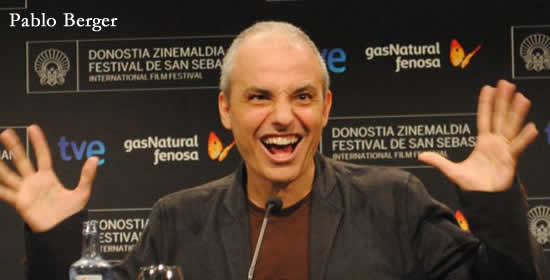 Pablo Berger‘s ravishing silent film “Blancanieves”, Spain’s official 2012 Oscar submission, is a must SEE. The moody, darkly comic fairytale, reset in a Bunuelesque gothic setting is full of silent film techniques, expressive multiple exposure images that harken back to early silent experimental films, and oneiric visual vignettes. Berger, a supreme stylist, always maintains an emotional through line. One of the best films of the year.
Pablo Berger‘s ravishing silent film “Blancanieves”, Spain’s official 2012 Oscar submission, is a must SEE. The moody, darkly comic fairytale, reset in a Bunuelesque gothic setting is full of silent film techniques, expressive multiple exposure images that harken back to early silent experimental films, and oneiric visual vignettes. Berger, a supreme stylist, always maintains an emotional through line. One of the best films of the year.
I interviewed him during the Oscar Foreign films campaign.
Robin Menken: I’m a major fan of “Torremolinos 73”, totally crazed for that film and I waited and waited for you to make another film. They are both conceptual films. This film contains one of my favorite Angela Molina performances in years: she is almost my favorite person in the whole movie and I wanted to ask you what was it like for her to work in silence. Angela reminds me a lot of Rossellini’s actors.
Pablo Berger: She says that she did not find any difference between working in a silent or in a talking film because the truth is Molina’s just in the moment. She cannot do rehearsals. I will tell you this anecdote- the scene where she realizes that her daughter has died and she is walking in the long hallway, it is a long shot and she just falls apart and obviously in cinema you have to do rehearsals for the assistant cameras and where the cameras are going to be, jus a technical thing. She does it and I say “Angela, muy bien, toto perfecto” and we continue working and I look from the corner of my eye and I see Angela in tears and completely broken because she had given the performance her all and it was for the cameras, and she knew it and every take is different. She lives, and it is really amazing after all the amount of movies and years, every scene, every moment she lives with such intensity. For me it was such a fun pleasure.
Robin: It’s like having a Stradivarius in your hands,
Pablo: It’s unbelievable.
Robin: A Stradivarius with a very freaked out player, like Toscanini who gets really upset.
Pablo: You have it right, I have never worked with an actress like her and it is something out of this world, I think she gave a magical performance.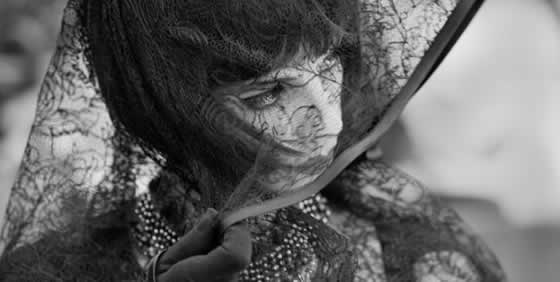
Robin: I’m getting chills taking about it. I did not know many others in the cast but I know Daniel Daniel Giménez who was in Ripstein’s “Virgin of Lust”, one of my favorite films.
Pablo: He is probably the biggest Mexican actor of his generation. If you research him he is on the A-list of Mexican actors of his generation, a monster on the level with Angela Molina and Maribel Verdú and he’s also worked in Spain. (“Cronis”, “Love In the Time Of Hysteria”, “Arráncame la vida”, “Bad Education”)
Robin: Is there anyway to see “Mama”? (“Mama”, Berger’s first film is a futuristic short. Alex de la Iglesia was the D.P.)
Pablo: There is a very bad version on YouTube.
Robin: I have heard wonderful things about it and I am a big fan of Alex (Inglesias) and I did not realize that you guys had worked together.
Pablo: We’re very close. We started together. He was the art director on “Mama”. We are from the same city and we grew up together making films and short films so we are close friends.
Robin: So there is no way to get a better version with subtitles from Spain or something?
Pablo: That’s a tough one, I would love to put it on as an extra, I tried to have it as an extra for “Torremolinos”, for the French version because the French love “Mama”, like there is a big following for “Mama” in France.
Robin: Do you think you might get “Mama” on as a DVD extra with this film?
Pablo: It’s a different producer from this film, but I am going to suggest that they put “Mama” on this dvd, because it is my first baby. I feel like this is the beginning of my career, so I would love it if they put it on as an extra.
Robin: I know that you have worked on Guillermo’s films and one of your producers, Gilles Waterkeyn, worked on “Asterix” and “The Last Circus”, so it seems that most of you guys have worked on the same team before.
Pablo: I think European cinema is a small, big family, we all know each other, so as I said, I am connected with Alex and we use the same DP (Kiko de la Rica) and in our last film I used the same wardrobe director as Alex (Paco Delgado). He did “The Last Circus” and he just did “Les Miserables”. He is one of the biggest European wardrobe persons, and he’s done all the Pedro Almodóvar movies. “The Artist” connection is a funny connection because we used the same Orchestra, the Philharmonic Orchestra of Brussels.
Robin: I remember you said you were trying to get this made and nobody had the vision and then “The Artist” came out, which turned out to be good for you.
Pablo: Yes, the script was finished in 2005, I started shopping the script around to producers and on the first page of the script it said it was in B&W and silent with music from beginning to end so obviously no one wanted to make a B&W silent, expensive and with 1:33 ratio, so people thought that I had gone crazy after “Torremolinos 73”, which had been a big success in Spain which had international art house commercial clout and won a lot of awards, even a Chinese remake called “Two Stupid Eggs.”
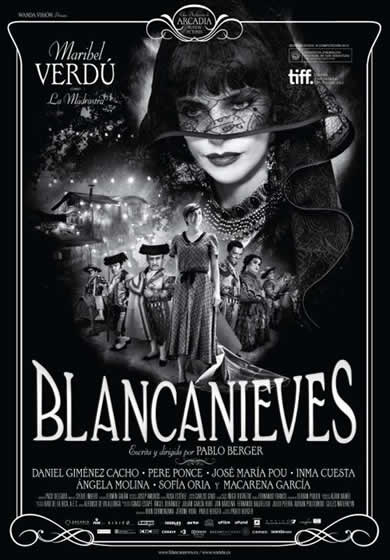 Robin: An official remake? They bought it from you?
Robin: An official remake? They bought it from you?
Pable: I got an upfront screen credit. It was a big success in China, a big budget movie for China with big actors. Suddenly, in 2005,I thought I had a career. I was happening, and in a way I was, but the reality is that nobody wanted to take such a huge risk on me. Of course they wanted to take a risk but not a big one. Finally I found a producer that is as crazy as me, Ibón Cormenzana, and he said okay. He told me the one of the things that writer-directors love to hear. He read it the same day I gave it him, which is amazing for a producer, and he said, “This is the best script that I have read in my life.” He said “I don’t know how we are going to make an expensive, period, black and white silent movie in 2006. I don’t know how we are going to get the money but we are going to get it”. I would have kissed him on the mouth even though we are both straight and I have a wife and daughter, because that is what I wanted to hear, a producer that really wanted to bet on this crazy project and he was willing to be with me all the way. We planned everything and we said that this has to be French co-production. We need to get Eurimages, which is a big help from the European Government. Then we got the support of CNC, Berlinale, Sundance, Suddenly we got all this support after all those years, but we did not get any support in Spain, because in Spain TV stations are like the studios and you need to have a TV station that buys the rights for your movie to get a green light, so we couldn’t get the support. Our production schedule went. Instead of having 11 weeks, we shot in 7 weeks and I had to take out some scenes from the script, but nothing that damaged the project; it probably made it better.
Robin: What did you take out?
Pablo: There were some scenes in the stepmother’s house, some Oliver Twist kind of themes, with the little girl suffering even more.
Robin: She suffered plenty.
Robin: I loved the little touches. You put in the pricking of the finger, even though it’s from a different fairy tale, and the fat girl in the Freak show was a wonderful little side plot: the setup where they audience goes to the Corrida. You repeat the shot, only the second time there’s a Zeppelin overhead. The superimposed feet sequence is so fantastic. The 360’s are fantastic, or the final bullfight, Carmen’s standing facing the bull with superimposed hands fluttering fans and clapping, all of these superimpositions were divine.
Pablo: This was all the little details, when someone is a film lover, and journalist and filmmaker you notice these things and I appreciate that you enjoy these little moments, I think cinema is about many, many little details that add up to something.
Robin: And some of them are discoveries, Renoir said (I’m paraphrasing). “Cinema is when you turn on the camera and something unexpected happens.” I thought it was very interesting that you used post-modern music. Can you talk about how you worked on the music? The idea of having the actual claps becomes part of the Flamenco score, and not sound effects. Really interesting.
Pablo: I worked very closely with Alfonso Vilallonga. We edited the film raw without any music, just picture, and once the movie was picture locked we started working with the composer, but we didn’t work chronologically, we worked little by little. I let him see what he was moved by and then he moved minute by minute and scene by scene and he would write like one minute of music or whatever would start up his creativity, and he would send it in and I would comment, and little by little, it was hard work, let me tell you. It was four months of intense work, just the composition and then, at some moment, I realized that we did not have enough time for him to get all the pieces together, so it became something natural that I would put in more flamenco. I said wouldn’t it be nice if during her childhood, and with Angela there was more flamenco and even for some of the final scenes there was the flamenco and the clapping and the guitar, so it became more present. We knew that because of the deadline we did not have enough time and sometimes we were working with Chicuelo, who is a very famous flamenco guitarist and there is this singer called Silvia Perez Cruz, she is a performer, she can sing flamenco, she can sing jazz. She is just a great performer and she has sung flamenco before. So there was this additional element, not only symphonic, but flamenco and we did something a little eclectic, because Alfonso Vilallonga does a lot of Cabaret and circus-like music, not in his film work but in his own music, so we wanted to make a soundtrack that would be eclectic. We didn’t want to make a soundtrack that could be used in any other movie, because there are certain composers, they do 6 or 7 soundtracks a year and they are all interchangeable.
Robin: There are certain chords that are used in every movie.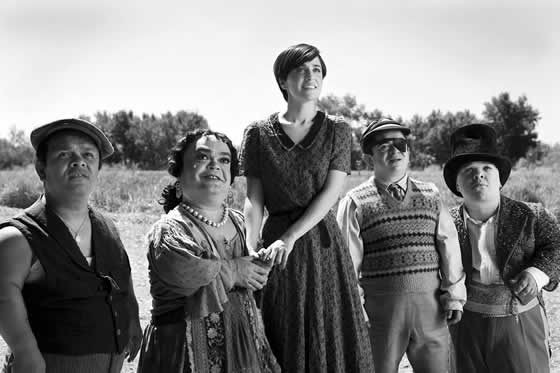
Pablo: In every single movie; for action or for scary moments
Robin: These slow, weird descending chords. And that almost sub-audible rumble, when did that happen? All of a sudden it’s everywhere, the same soundtrack.
Pablo: I didn’t want to work with that type of composer. Alfonso only makes one score every year or every two years because he is not only a film composer; he is a composer. If you go to Spotify you will see he has seven CD’s of his own music. Spotify is like an IMDB of music. He has his own career as a performer.
Robin: I love the whole subplot with Pepe, which was reminiscent of American rural silent Films, Mary Pickford films. All those great superimpositions, like Pepe’s head and seeing her father up in the clouds, how did you discuss that with your cinematographer?
Pablo: That was more like working with the editor and planning the storyboards. It took two years to do the storyboards. The storyboards are the size of the phone book. In a way it was made in my head. We just had to follow the plans, like an architect’s plans. All the superimpositions were done in the storyboards and in the editing room.
Robin: You should bring that book out as a fine art collectable.
Pablo: We want to do that. We are really looking forward to doing it so, definitely.
Robin: I like all of the unique, quirky characters that appear. It’s a movie that has a lot of characters and each has a clear arc. It’s like “Torremolinos’73”. It’s what I love in films, what I write in screenplays, what Preston Sturges wrote, character arcs for each player. In any frame with a character you know where they are going. Their own crazy arc is visible in every scene that they are in.
Pablo: Everything that appears in a film is important. There is no detail that appears on the screen that is not important.
Robin: I loved the dyeing of the dress as a transition, and the transition of Carmen hanging the clothes and them suddenly she was older. The transitions were fantastic in this movie.
Pablo: I love that you picked up those transitions because those two are extremely important transitions. You point out each transition that changes the acts: you change the act when the dress gets black, you change the act when she becomes older.
Robin: I loved the way you handled the sequences of the traveling circus and I also loved the sequence- this was all very noir, when Carmen is reading the Photo-Journal, and she was promised the cover picture, that’s a fantastic, funny
Pablo: That is our mirror, of our Snow White
Robin: Oh! That’s hilarious.
Pablo: The mirror-mirror scene.
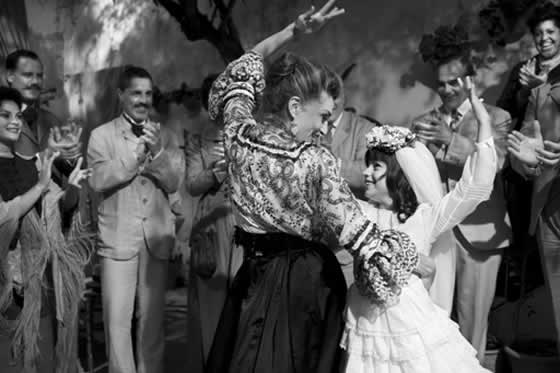 Robin: And you really dragged it out to the very end how you were going to have her wake up; she didn’t actually wake up which is very Spanish, it’s very Mater Dolorosa. It is very classical Spanish, mournful, dark.
Robin: And you really dragged it out to the very end how you were going to have her wake up; she didn’t actually wake up which is very Spanish, it’s very Mater Dolorosa. It is very classical Spanish, mournful, dark.
Pablo: It’s very Bunuel. Very “Viridiana”. I think the film is full of homages to the directors I love the most.
Robin: I love is this a miracle or a curse, the idea of having her comatose body be kissed, that’s very “Viridiana” also the idea of sitting the corpse up and the series of black out jokes with each person sitting there posing with her father’s corpse, ending with Carmen holding him in her arm and crying when they say “smile.” It’s just too much, that’s a fantastic little montage.
Pablo: Dark humor and death is part of the Spanish society, our culture and I think we cannot take life so seriously and we have to be able to laugh even in the saddest moments, so I think that is the only way to survive.
Robin: What’s next for you?
Pablo: Right now I am in the middle of madness. I have a few scripts that I have written because it took me so long to get this project off the ground, but I really don’t know, I have to have something that really drives me crazy because every film that I make, it’s almost like the last one.
Robin: That’s good. Then you give it everything.
Pablo: I like to give it everything. I’m not a director that can make one film after another one. The last film I did I loved so much, I have to give it everything.
Robin: I just want to say this movie is better than any reviews I read about it, better than what people said about it, and I am your old-school fan.
Pablo: You’ve seen so many films and you know so much about cinema it’s a nice complement.
Robin: I liked it in a way better than “The Artist”. I liked “the Artist also but I had problems with it. Do you know Javier Fesser (“The Miracle of P. Tinto”) by any chance? How’s he doing?
Pablo: I know him. He’s always doing unique projects. He also is a personal director. He is going to make a big budget animated film.
Robin: I love those weird little shorts that he did. Totally amazing (“El Secdleto de la Tlompeta” and “El Ritmo”). And one of those guys is in your movie.
Pablo: Yes!
Robin: One of those guys from “P.Tinto”
Pablo: The bad dwarf.
Robin: Jesusin (Emilio Gavira). He’s quite good.
Pablo: He’s great.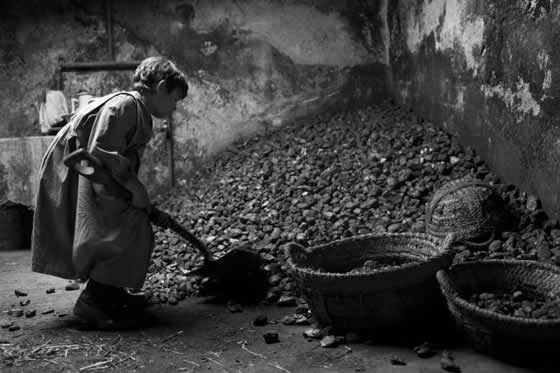
Robin: What gave you the idea for the kissing scenes and to sit up the corpse. I know you thought about Bunuel, but what gave you those Ideas?
Pablo: I don’t write. I just vomit images. When I write, I get in some kind of state. I feel possessed like the girl in “The Exorcist”. I just start writing, I don’t even think, it’s more of a surrealistic thing. I just go write, and then when I’ve written like four pages, I look back, but I just write images. For me cinema is about images, about visual poetry, it’s about contrast, it is nothing that you can analyze too clearly.
Robin: When you talk about Angela walking up that hallway, it is one of my favorite scenes. One of my favorite actors is Alec Guinness. He has a different walk for every character. He is more interesting walking away then many actors are working a face
Pablo: What you don’t see in cinema is sometimes more important, I believe that. Sometimes you don’t need a close up, you need a shot from the back.
Robin: Speaking of blackouts, what about the first ten minutes of “The Wrong Box?” (directed by Bryan Forbes, script by Larry Gelbart.) So we didn’t talk about was how you got the beautiful black and whites and contrast.
Pablo: It was shot in color, most modern black and white movies are shot in color, “The Artist” to the Cohen brothers, and we shot it on Kodak Super 16mm, because I love the grain and we did not want to shoot in digital and we wanted to use the old cameras because back then the cameras were very light, hand-held, and we wanted to put it in very unique places. We had two camera’s shooting constantly
Robin: Were you coaching people during the shots since the film was silent?
Pablo: Yeah, yeah, I was coaching like in silent shoots. The person that did the storyboards on my film was the second unit director so he knew the material and he is one of my best friends, like a brother to me his name is Enigo Rotaeche.
Robin: Now you have it in the can and you have the grain, did you do massive color correction?
Pablo: Color correction, in post.
Robin: Was that very expensive?
Pablo: Yes, a big part of our budget was digital effects color correcting the film. Believe it or not our film has over 600 shots with some kind of digital effects and color manipulation. People don’t see it but the film is full of it. The color correction was a big part of the process.

